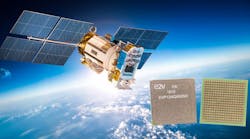This article appeared in Microwaves & RF and has been published here with permission.
The industry’s first four-channel analog-to-digital converter (ADC) qualified for space applications has been confirmed by Teledyne e2v. The company’s model EV12AQ600 ADC is a radiation-hardened device that can withstand a total ionizing dose (TID) of 150 kRad and provides the exceptional reliability needed to survive long-term missions in satellites and other space vehicles. It meets NASA and ESA requirements according to MIL-PRF-38535 (ML-Y) and ESCC 9000 standards.
The model EV12AQ600 ADC (see image above) features 12-bit resolution and 1.6 GS/s maximum sampling rate across each channel or a maximum rate of 6.4 GS/s for one channel when the four channels are interleaved. The space-qualified ADC can be programmed remotely, such as when the device is in orbit, thanks to a cross-point switch following the input ports and an accompanying Xilinx model XQRKU060 field-programmable gate array (FPGA). Programming of such parameters as the number of channels, the bit rate, and the dynamic range can be changed while the FPGA is in space. In addition, a collection of FPGA libraries is available to support different applications using the FPGA ecosystem.
“Through our space-qualified EV12AQ600 devices, we are able to offer customers high-performance data-converter solutions that are ready to integrate directly into their systems,” explains Nicolas Chantier, marketing director at Teledyne e2v. “It means that they can benefit from flight-proven TRL9 technology, without the need for any further qualification effort. Also, with inventory now available, there are much shorter lead times associated with these ADCs than competing solutions currently on the market. Customers can therefore get access to samples straight away.”
Measurement data related to the space qualification of the four-channel ADC, including extensive shock, vibration, and electrostatic-discharge (ESD) testing, can be found at the company's website.
